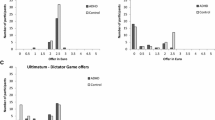Abstract
Approach-avoidance conflict in children was related to a risk situation where risk was defined as the relative magnitude of approach and avoidance tendencies. In this context the risk was a specific win-lose ratio fixed by E. Decision latency was measured for each S on a series of decisions leading to a final decision to quit or play a game. Both win-lose ratio and incentive affected the number of children who quit playing and their trial of longest latency.
Similar content being viewed by others
References
ATTHOWE, J. M. 1960. Types of conflict and their resolution. Journal of Experimental Psychology, 59, 1–9.
ATTHOWE, J. M., & SIEGEL, S. 1961. Decision making and conflict theory: Approach avoidance gradients. Pennsylvania State University Research Bulletin, No. 14, April.
DAVIS, C. M. 1965. Development of the probability concept in children. Child Development, 36, 779–788.
EDWARDS, A. 1960. Experimental design in psychological research. New York: Holt, Rinehart & Winston.
HOVLAND, C., & SEARS, R. 1938. Experiments on motor conflict: I. Types of conflict and their mode of resolution. Journal of Experimental Psychology, 23, 477–493.
KAGAN, J., et. al. 1964. Information processing in the child: Significance of analytic and reflective attitudes. Psychological Monographs, (Whole No. 578).
KASS, N. 1964. Risk in decision-making as a function of age, sex and probability preference. Child Development, 35, 577–582.
LINDQUIST, E. 1956. Design and analysis of experiments in psychology and education. Boston: Houghton Mifflin.
MILLER, N. E. 1944. Experimental studies in conflict. In J. McV. Hunt (Ed.), Personality and the behavior disorders. New York: Ronald Press. Pp. 431–465.
MILLER, N. E. 1959. Liberalization of basic S-R concepts: Extension to conflict behavior, motivation, and social learning. In Koch, S. (Ed.), Psychology the study of a science, Vol. II. New York: McGraw-Hill.
SLOVIC, P. 1964. The relative influence of probabilities and payoffs upon perceived risk of a gamble. Psychonomic Science, 9, 223–224.
SLOVIC, P. 1966. Risk-taking in children: Age and sex differences. Child Development, 37, 169–176.
STEVENSON, H., & HOVING, K. 1964. Probability learning as a function of age and incentive. Journal of Experimental Child Psychology, 1, 64–70.
WORELL, L. 1962. Response to conflict as determined by prior exposure to conflict. Journal of Abnormal and Social Psychology, 64, 438–445.
WORELL, L. 1963. Intraindividual instability and conflict. Journal of Abnormal and Social Psychology, 66, 480–488.
Author information
Authors and Affiliations
Additional information
Portions of this experiment were part of a doctoral dissertation completed by the senior author at the University of Pittsburgh in 1966.
Rights and permissions
About this article
Cite this article
Schroeder, C.A., Schroeder, S.R. Decision Conflict in Children in a Risk Situation. Psychol Rec 20, 457–463 (1970). https://doi.org/10.1007/BF03393966
Published:
Issue Date:
DOI: https://doi.org/10.1007/BF03393966




